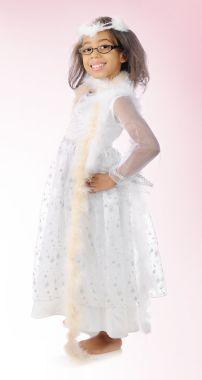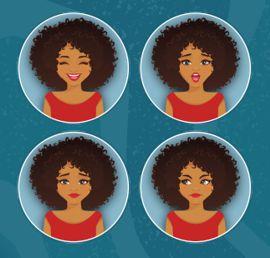Printable activities for younger children Lesson Plan
A Princess Story – Printable activity sheet
Grades 2-6

This printable activity sheet introduces basic media literacy skills and concepts and is suitable for use in homes, schools and libraries. It can be completed independently, but children will learn more if you discuss the activity with them. Younger children may need help reading the instructions and completing the activity.
This activity is followed by a list of other MediaSmarts resources that can be used to extend the learning.
This activity helps kids recognize and ask questions about gender stereotypes. Working with a friend or family member, kids fill in the blanks of a princess story. Reading the story they wrote together highlights how stereotypes narrow our idea of what people can be and do.
Supporting resources
Tipsheet: Talking to Kids About Gender Stereotypes
Images of men and women in the media are often based on stereotypical roles of males and females in our society. Because stereotyping can affect how children feel about themselves and how they relate to others, it's important that they learn to recognize and understand gender stereotypes in different media.
Workshop: Half Girl, Half Face
Intended for girls in grades 7-9, Half Girl, Half Face explores many of the online image issues teenage girls may encounter when they use digital media – particularly social networks.
Video: You Do You!
Girls don't always have to be pink princesses and boys, blue superheroes even though that's often what we see in the media. We're all different and unique, and we can avoid stereotypes by just being ourselves. You do you
Lessons:
Once Upon a Time
Students are introduced to stereotypes by brainstorming the characteristics that are associated with stock characters from fairy tales and Disney films.
Comic Book Characters
Students look at how male and female characters are depicted in comic books.
Media Kids
Students explore gender stereotypes and representation and compare these representations to their own life experiences.
Girls and Boys on Television
Students illustrate what they dislike about portrayals of girls or boys and then create their own TV character who will counter the illustrated negative portrayals.
Just a Joke? Printable activity sheet
Grades 3-7
 This printable activity sheet introduces basic media literacy skills and concepts and is suitable for use in homes, schools and libraries. It can be completed independently, but children will learn more if you discuss the activity with them. Younger children may need help reading the instructions and completing the activity.
This printable activity sheet introduces basic media literacy skills and concepts and is suitable for use in homes, schools and libraries. It can be completed independently, but children will learn more if you discuss the activity with them. Younger children may need help reading the instructions and completing the activity.
This activity is followed by a list of other MediaSmarts resources that can be used to extend the learning.
In this activity, kids learn how emojis can be used to show people how they feel when communicating online.
Supporting resources
Workshop: Respecting Yourself and Others
This workshop was created to provide tweens and young teens with strategies and knowledge that will help them respect themselves, respect others and respect the space when using social media.
Tipsheet: Building Empathy in Children and Teens
This tipsheet explores how to foster empathy in children, teens and tweens and how to remind them to use it when they’re communicating online.
Videos:
Let’s Connect!
Just like in real life, when we connect with online friends, it's important to show respect. Let's keep a positive attitude and not be rude! Make sure you feel safe and treat others well, and the fun will never end!
The Emoji Dance!
Sometimes words aren't enough to get your meaning across. That's where emojis come in. Words and emojis make a great team. Do the emoji dance with Ava and end it with a big happy face emoji!
Lessons:
Behaving Ethically Online: Ethics and Empathy
In this lesson students are introduced to the idea that “hot” emotional states such as anger or excitement can make it harder for them to control how they act.
Behaving Ethically Online: Ethics and Values
In this lesson students consider how we come to hold values and how they affect our behaviour, especially online.
Calling Out versus Calling In: Helping youth respond to casual prejudice online
This lesson introduces students to the idea of “calling in” – reaching out to someone privately with the assumption that they didn’t mean to do any harm – and explores how this idea can be applied both to casual prejudice online and when responding to stereotyping and other negative representations in media.
Understanding Cyberbullying : Virtual vs. Physical Worlds
In this lesson students explore the verbal and visual cues that we rely on to understand how other people are feeling. They then consider the differences between online and offline communication and discuss how these differences may make it difficult to understand the effect our words and actions have on others online.
Just a joke? Helping youth respond to casual prejudice
In this lesson, students analyze media representations of relational aggression, such as sarcasm and put-down humour, then consider the ways in which digital communication may make it harder to recognize irony or satire and easier to hurt someone’s feelings without knowing it.
What is this cereal box saying? Printable activity sheet
Grades 1-5
 This printable activity sheet introduces basic media literacy skills and concepts and is suitable for use in homes, schools and libraries. It can be completed independently, but children will learn more if you discuss the activity with them. Younger children may need help reading the instructions and completing the activity.
This printable activity sheet introduces basic media literacy skills and concepts and is suitable for use in homes, schools and libraries. It can be completed independently, but children will learn more if you discuss the activity with them. Younger children may need help reading the instructions and completing the activity.
This activity is followed by a list of other MediaSmarts resources that can be used to extend the learning.
What is this cereal box saying? (ages 5-10)
This activity introduces the idea that media are everywhere – including our own cupboards and grocery store shelves – and are the result of choices that were made with particular purposes in mind.
The first part of this activity invites children to spot and colour in the different tricks that advertisers use to make kids notice a cereal box and ask their parents to buy it. The second part invites them to create their own cereal box that show their understanding of the same tricks.
Supporting resources
Tip sheet: Talking to kids about advertising
Today’s kids have become the most marketed-to generation in history, due to their spending power and their future influence as adult consumers. By talking to kids about advertising - how it works and how they’re targeted - we can help them to become more savvy as consumers and more resistant to the pressures to be “cool.”
Lessons
Can you spot the ad? (Grades K-3)
Students learn about the concept of branded content and will learn to differentiate between branded images and videos and non-branded images and videos in online and offline contexts through a series of questions and discussions.
Advertising all around us (Grades 5-6)
This lesson helps students to become more aware of the language and techniques used in print advertising, as well as the impact of advertising on their daily lives.
Videos
What is media anyway?
This video provides an introduction to various forms of media from traditional print, television and radio, to websites, online media and social networking.
Media are constructions
Using the analogy of building a house, this video demonstrates that media combines carefully crafted elements to engage specific audiences to achieve specific outcomes.
We’ll make them want it!
Packaging is the marketers’ last chance to convince us to buy their product. They have to grab our attention right away. Ava designs a package as she sings about the different packaging tricks marketers use to make kids say: “Wow! I want that!”
Media is everywhere!
From billboards to magazines, music, apps, text messages and even the logo on your jacket, media is any form of communication that gets messages across to an audience. Ava sings about all the media surrounding us 24/7!
Spot the house hippos – Printable activity sheet
Grades 4-9
 This printable activity sheet introduces basic media literacy skills and concepts and is suitable for use in homes, schools and libraries. It can be completed independently, but children will learn more if you discuss the activity with them. Younger children may need help reading the instructions and completing the activity.
This printable activity sheet introduces basic media literacy skills and concepts and is suitable for use in homes, schools and libraries. It can be completed independently, but children will learn more if you discuss the activity with them. Younger children may need help reading the instructions and completing the activity.
This activity is followed by a list of other MediaSmarts resources that can be used to extend the learning.
Spot the house hippos (ages 8-13)
For more than 20 years, house hippos have been helping teach kids to think critically about media. In this activity, five of them are hiding in a very messy room. Kids can turn the page to make sure they spotted them all and also learn five ways to verify anything they’ve seen online.
Supporting resources
Tip sheet: Break the Fake: How to tell what’s true online
Here are four quick and easy steps to find out the truth and share good information. Sometimes you only have to do one of these things, and most steps take less than a minute.
Lessons
Break the Fake: What’s real online? (grades 3-5)
In this lesson, students are introduced to the challenges of identifying what is real and what is fake online. After learning some simple steps to verify online information they create a poster that communicates the importance of questioning and double-checking online content.
Break the Fake: Verifying information online (grades 6-9)
In this lesson, students participate in a workshop that teaches them four quick, easy steps to verify online information. After practicing these four steps they create a public service announcement aimed at teaching one of these steps and spreading the message that it is necessary for everyone to fact-check information we see online every time we are going to share it or act on it.
Videos
House Hippo 2.0
The hippos are back to remind us that in today's digital world, critical thinking is more important than ever.
Four ways to tell if something is true online
Here are four steps you can take to determine whether a post or a story is true or not true.
Reality Check: Authentication 101
Because anyone can create and share internet content, you need to take extra steps to ensure what you find is accurate. Here are a few tips to help you separate good information from bad.
